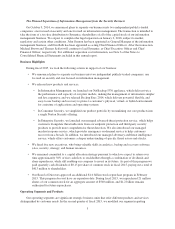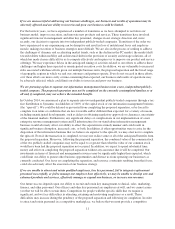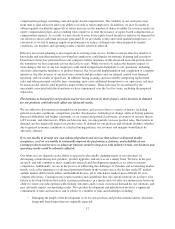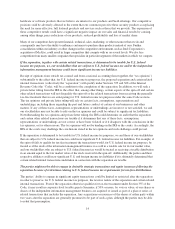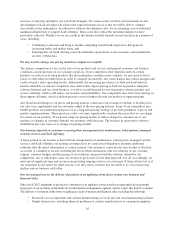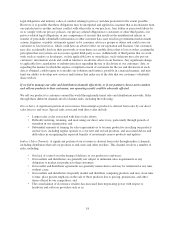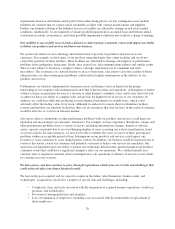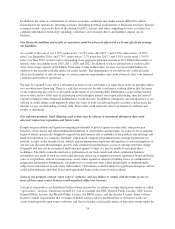Symantec 2015 Annual Report Download - page 92
Download and view the complete annual report
Please find page 92 of the 2015 Symantec annual report below. You can navigate through the pages in the report by either clicking on the pages listed below, or by using the keyword search tool below to find specific information within the annual report.hardware or software products that we believe are inferior to our products and SaaS offerings. Our competitive
position could be adversely affected to the extent that our customers perceive these security products as replacing
the need for more effective, full featured products and services such as those that we provide. The expansion of
these competitive trends could have a significant negative impact on our sales and financial results by causing,
among other things, price reductions of our products, reduced profitability and loss of market share.
Many of our competitors have greater financial, technical, sales, marketing, or other resources than we do and
consequently may have the ability to influence customers to purchase their products instead of ours. Further
consolidation within our industry or other changes in the competitive environment, such as Intel Corporation’s
acquisition of McAfee, could result in larger competitors that compete with us on several levels. We also face
competition from many smaller companies that specialize in particular segments of the markets in which we compete.
If the separation, together with certain related transactions, is determined to be taxable for U.S. federal
income tax purposes, we, our stockholders that are subject to U.S. federal income tax and/or the independent
information management business could incur significant income tax liabilities.
Receipt of opinions from outside tax counsel and from a national accounting firm (together, the “tax opinions”)
substantially to the effect that, for U.S. federal income tax purposes, the proposed separation and certain related
internal transactions (collectively the “separation”) will qualify under Sections 355 and 368 of the Internal
Revenue Code (the “Code), will be a condition to the completion of the separation. In addition, we will seek a
private letter ruling from the IRS to the effect that, among other things, certain aspects of the spin-off and certain
other related transactions will not disqualify the spin-off or the related transactions from receiving the generally
tax-free treatment that we are anticipating for U.S. federal income tax purposes under the same Code sections.
The tax opinions and private letter ruling will rely on certain facts, assumptions, representations and
undertakings, including those regarding the past and future conduct of certain of our businesses and other
matters. If any of these facts, assumptions, representations or undertakings are incorrect or not satisfied, we and
our stockholders may not be able to rely on the tax opinions and could be subject to significant tax liabilities.
Notwithstanding the tax opinions and private letter ruling, the IRS could determine on audit that the separation
and certain other related transactions are taxable if it determines that any of these facts, assumptions,
representations or undertakings are not correct or have been violated or if it disagrees with the conclusions in the
tax opinions, or for other reasons. The tax opinions will not be binding on the IRS or the courts. Accordingly, the
IRS or the courts may challenge the conclusions stated in the tax opinions and such challenge could prevail.
If the separation is determined to be taxable for U.S. federal income tax purposes, we and those of our stockholders
that are subject to U.S. federal income tax could incur significant U.S. federal income tax liabilities. For example, if
the spin-off fails to qualify for tax-free treatment, the transactions would, for U.S. federal income tax purposes, be
treated as if the stock of the information management business was sold in a taxable sale for its fair market value,
and our stockholders who are subject to U.S. federal income tax would be treated as receiving a taxable distribution
in an amount equal to the fair market value of the stock received in the spin-off. Additionally, the parties and their
respective affiliates could incur significant U.S. and foreign income tax liabilities if it is ultimately determined that
certain related internal transactions undertaken in connection with the separation are taxable.
The parties might not be able to engage in desirable strategic transactions and equity issuances following the
separation because of restrictions relating to U.S. federal income tax requirements for tax-free distributions.
The parties’ ability to engage in significant equity transactions could be limited or restricted after the separation
in order to preserve, for U.S. federal income tax purposes, the tax-free nature of the separation and certain related
internal transactions. Even if the separation otherwise qualifies for tax-free treatment under Section 355 of the
Code, it may result in corporate-level taxable gain to Symantec if 50% or more, by vote or value, of our shares or
shares of the independent information management business are acquired or issued as part of a plan or series of
related transactions that includes the separation. Any acquisitions or issuances of the shares of either party within
two years after the separation are generally presumed to be part of such a plan, although the parties may be able
to rebut that presumption.
14



